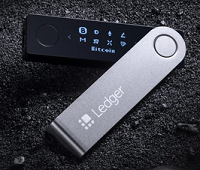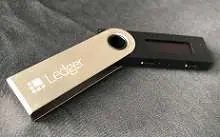Navigating the vast landscape of cryptocurrency wallets can be daunting, especially when you’re dealing with a cutting-edge blockchain platform like Polkadot (DOT). This guide aims to simplify your journey, providing a detailed look at the top Polkadot wallets across three categories: hardware, desktop, and exchange-based wallets.
Each type offers unique advantages and considerations, ensuring there’s an option tailored to every need and security preference. If you want to check the current DOT price, you can have a look at our live Polkadot (DOT) price chart. A detailed guide on how to buy DOT can be found in our Polkadot Buying Guide 2024. The latest Polkadot news is published here.
Polkadot Hardware Wallets: The Fortresses of Cryptocurrency Storage
- Ledger Nano X
- Pros: Ledger Nano X is renowned for its robust security features, including a secure chip and PIN code. It supports a wide range of cryptocurrencies, including DOT, and allows for mobile connectivity via Bluetooth.
- Cons: Its high security comes with a higher price tag compared to other wallets. Bluetooth connectivity, while convenient, may raise concerns for the most security-conscious users.
- Trezor Model T
- Pros: The Trezor Model T features a touchscreen interface for improved usability and supports an extensive list of cryptocurrencies. It’s known for its open-source firmware, which enhances security transparency.
- Cons: Like the Ledger, it’s on the pricier side. The touchscreen, although user-friendly, could be susceptible to wear and tear over time.
- SafePal S1
- Pros: SafePal S1 stands out for its affordability and high-security features, including a self-destruct mechanism for tamper protection. It’s also backed by Binance, adding an extra layer of credibility.
- Cons: Its lesser-known brand might not inspire the same level of trust as Ledger or Trezor. The user interface is not as refined, which might deter less tech-savvy users.
Desktop Wallets: Combining Convenience with Security
- Polkadot.js
- Pros: The official Polkadot.js wallet offers direct integration with the Polkadot network, ensuring up-to-date compatibility and features. It’s open-source, providing transparency and community trust.
- Cons: Its interface can be complex for beginners, and being a hot wallet, it’s inherently less secure than hardware options.
- Exodus
- Pros: Exodus is known for its sleek user interface and multi-currency support, making it a great all-in-one wallet solution. It also offers one-click staking for DOT.
- Cons: The lack of custom network fees might not appeal to more advanced users, and it’s not as secure as a hardware wallet.
- Atomic Wallet
- Pros: Atomic Wallet supports a wide array of cryptocurrencies, including DOT, and offers built-in exchange features. It’s also known for its strong encryption and custody-free solution.
- Cons: The built-in exchange rates can be high, and like other desktop wallets, it cannot match the physical security of hardware options.
Exchange Wallets: Ease of Use and Instant Access
- Binance
- Pros: Binance is one of the largest and most reputable cryptocurrency exchanges, offering an integrated wallet with high liquidity for DOT trading. Features 2FA for added security.
- Cons: Exchange wallets are more vulnerable to hacks, and users do not control their private keys.
- Kraken
- Pros: Kraken is known for its robust security measures and has never been hacked. It provides a seamless experience for trading and storing DOT.
- Cons: Like all exchange wallets, there’s a trade-off between convenience and the higher risk associated with not holding your private keys.
- Coinbase
- Pros: Coinbase offers a user-friendly interface perfect for beginners, insured wallets, and the ability to trade a wide range of cryptocurrencies, including DOT.
- Cons: It exercises control over your funds, and privacy-concerned users might find its KYC requirements intrusive.
Choosing Your Polkadot Wallet
When selecting a wallet for your DOT tokens, consider what matters most to you: Is it the impenetrable security of hardware wallets, the convenience and functionality of desktop options, or the ease of access and liquidity provided by exchange wallets? Each wallet type offers a different balance of security, convenience, and functionality, so weigh these factors based on your personal needs and risk tolerance.
Remember, the ultimate responsibility for your digital assets’ security rests with you. Whichever wallet you choose, ensure you follow best practices like using strong, unique passwords, enabling two-factor authentication, and regularly backing up your wallet.
Subscribe to our daily newsletter!
No spam, no lies, only insights. You can unsubscribe at any time.







